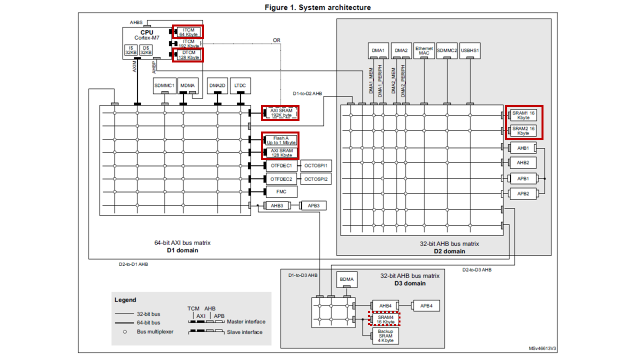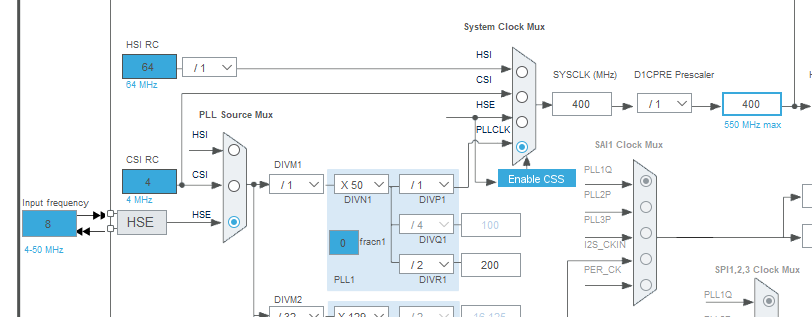-
Picking template code: linker scripts
06/05/2023 at 07:05 • 0 commentsAdding a new target to BF shouldn't be too hard if the new target is similar to an already existing target - right? Let's see what we have
- STM32H743: a bit older
- STM32H730: somewhat special, because:
- This chip uses external memory to store the application
- but it shares a reference manual with H723, H725, H733, and H735
- STM32H723: as far as I know, this was just a draft and never actually worked.
Let's take a closer look at the H743.
Memory areas
BF's H743 target uses a slightly customized layout that reserves flash for the reset handler and an emulated eeprom. Both BF and CubeIDE define areas in ITCM and DTCM for critical functions and data. Here's a table that compares BF's H743 memory areas with CubeIDE's H725/H735 standard:
BF H743 CubeIDE H725/H735 FLASH (reset handler) FLASH FLASH_CONFIG (emulated EEPROM) FLASH1 (application and constants) ITCM_RAM ITCMRAM DTCM_RAM DTCMRAM RAM RAM_D1 D2_RAM RAM_D2 MEMORY_B1 (*) RAM_D3 (**) *) external memory, can only be used if there's actually some external memory connected to the MCU
**) not used by BF so we can hopefully remove that. Or not, since simply having a memory area in a linker script doesn't hurt.
The BF linker script also defines two aliases:
REGION_ALIAS("STACKRAM", DTCM_RAM) REGION_ALIAS("FASTRAM", DTCM_RAM)The memory area names are a bit different between BF and CubeIDE but that's not a problem because these are only used within the linker script. A little understanding surely doesn't hurt so let's also have a look at the system architecture diagram for the H725. I've already marked the memories used:
- Top left: ITCM and DTCM are tightly coupled with the core for fast access.
- Center: Flash and SRAM in D1 domain via AXI
- Right: SRAM1 and SRAM2 in D2 domain via AXI and D1-to-D2 AHB
- Bottom: SRAM4 in D3 domain via AXI and D1-to-D3 AHB; not used by BF
The two DMA blocks in D2 domain (DMA1 and DMA2) allow for fast transfers between memory and peripherals within that domain, and we see something similar for BDMA (basic DMA) in D3 domain. The MDMA controller also has access to blocks in D2 domain, but that's somewhat convoluted. So we do see why it make sense to deliberately place certain I/O buffers in D2 memory ("D2_RAM" or "RAM_D2" in the table above).
Now we'd like to bring BF's memory areas over to the CubeIDE project. Turns out we can pretty much copy and paste them, as long as everything remains consistent within the linker script. A quick test reveals that the dev board still runs blinky after doing that. Great!
Memory Sections
The linker script further defines a number of memory sections. For plain old C we typically see
- ".text" (instructions),
- ".data" (initialized variables) and
- ".bss" (uninitialized variables)
But there's a lot more, because we need to place certain instructions in certain locations: reset handler and other ISRs need to be placed correctly in flash, and there has to be a section in ITCM that we can used to properly place functions that are supposed to be executed faster than others. Similarly, certain variables go into DTCM and I/O buffers into SRAM in D2 domain. And thus we end up with something like this:
BF H743 CubeIDE H735 .isr_vector >FLASH .isr_vector >FLASH .text >FLASH1 .text >FLASH .rodata >FLASH .tcm_code >ITCM_RAM AT >FLASH1 .ARM.extab >FLASH1 .ARM.extab >FLASH .ARM >FLASH1 .ARM >FLASH .pg_registry >FLASH1 .pg_resetdata >FLASH1 .preinit_array >FLASH .init_array >FLASH .fini_array >FLASH .data >RAM AT >FLASH1 .data >RAM_D1 AT >FLASH .bss >RAM .bss > RAM_D1 .sram2 >RAM .fastram_data >FASTRAM AT >FLASH1 .fastram_bss >FASTRAM .dmaram_data >RAM AT >FLASH1 .dmaram_bss >RAM .DMA_RAM >RAM .DMA_RW_D2 >D2_RAM .DMA_RW_AXI >RAM .persistent_data >RAM ._user_heap_stack >STACKRAM = 0xa5 ._user_heap_stack >RAM_D1 .memory_b1_text >MEMORY_B1 Let's take a look at the similarities first: All "basic" sections have identical names (.isr_vector, .text, .data, ._user_heap_stack) and end up in similar memories. The purpose of some of the additional sections defined In BF's linker script isn't too obvious to me, but let's try:
- .tcm_code: a section for code that will be copied to ITCM for fast execution. This needs to be stored in flash as well, so that it can be copied during startup.
- .pg_registry: no clue.
- .pg_resetdata: same!
- .sram2: ends up in RAM, might be a leftover from older targets? I don't know.
- .fastram_data and .fastram_bss: these go into DTCM
- .dmaram_data and .dmaram_bss: my guess: some of BF's old code might have been written for MCUs that can't use DMA in all RAM locations. For those, it would have been required to explicitly locate DMA-able variables in DMA-able memory.
- .DMA_RAM: my guess is that the purpose of this section is similar to that of dmaram_data and dmaram_bss, and whoever introduced it couldn't find those sections.
- .persistent_data: seems a bit weird here as it's simply placed in RAM. There would be battery backed RAM available (see system architecture diagram above, D3 domain), but it's not used. Maybe some MCUs also have RAM areas that aren't altered by some reset sources. Let's ignore this one.
- .memory_b1_text: used in other targets that actually have external memory.
On the other side we have some extras in CubeIDE's linker script:
- .rodata: constants stored in flash, nothing special. Would otherwise end up in .text
- .preinit_array, .init_array and .fini_array: Used for C++ constructor and destructors. Not relevant in a simple C application
Transferring all of BF's memory sections to my CubeIDE blinky project and removing the C++ constructor/destructor sections from it didn't break anything. It still blinks!
Next I'll try to alter the CubeIDE project's startup code to do more of what BF is doing. After that, and if it's still not broken then, it might make sense to transfer things back to betaflight.
-
Working Hardware
06/02/2023 at 21:55 • 0 commentsWe're working with the "Chonker H735" board which was developed solely for the purpose of bringing up the BF target.
Repo: https://github.com/crteensy/yolo-chonker
Several of these were built, some with just the base necessities like
- MCU and optional 8 MHz resonator
- USB connector
- 3V3 regulator
- two LEDs on GPIOs
Writing basic blinky code in STM32CubeIDE won't get us the desired files we need for the BF target, but it's easy and provides us with:
- some valid linker script
- some valid startup code
- a valid (limited) clock tree setup
The main() function then might look like this:
int main(void) { HAL_Init(); SystemClock_Config(); MX_GPIO_Init(); while (1) { HAL_Delay(500); HAL_GPIO_TogglePin(led_blue_A10_GPIO_Port, led_blue_A10_Pin); } }There's not a lot we could remove from this. Some things to note though:
- HAL_Init() is called first,
- even before SystemClock_Config(),
- and then we initialize the actual peripherals.
However, there's a lot of stuff happening before main() is even entered: that's the startup code which includes the reset handler. It's written in assembler, but the first thing it does after setting up the stack pointer is to call SystemInit(), which is written in C again:
startup_stm32h735vghx.s:
Reset_Handler: ldr sp, =_estack /* set stack pointer */ /* Call the clock system initialization function.*/ bl SystemInit ...
system_stm32h7xx.c:
void SystemInit (void) { #if defined (DATA_IN_D2_SRAM) __IO uint32_t tmpreg; #endif /* DATA_IN_D2_SRAM */ ...SystemInit() configures things like FPU, Flash timing, available oscillators (there are a few of them, both internal and external), resets the PLL, and configures the interrupt vector table.
After that, we're back in the asm startup code (startup_stm32h735vghx.s) with a bunch of snippets like this one:
/* Copy the data segment initializers from flash to SRAM */ ldr r0, =_sdata ldr r1, =_edata ldr r2, =_sidata movs r3, #0 b LoopCopyDataInit CopyDataInit: ldr r4, [r2, r3] str r4, [r0, r3] adds r3, r3, #4 LoopCopyDataInit: adds r4, r0, r3 cmp r4, r1 bcc CopyDataInit
_sdata, _edata and _sidata are defined in the linker script. The snippet shown above copies data from flash to RAM. This data is used to initialize variables that were defined an initialized somewhere in the code, for example:
static uint8_t foo = 3;The initialization value can only be stored in flash to survive a reset, but the variable itself resides in RAM during runtime - so the init code has to copy the init value to that RAM location during startup to prepare everything for the code that later relies on that variable to be properly initialized.
There are other sections for variables that are initialized to zero, or not initialized at all. What we need to know now is what sections are generated by STM32CubeIDE, so that we can compare those sections with the sections in a linker script used in a working BF target.
Each of these sections has to be placed in some memory area (like flash, or RAM, and some sub-areas of those). These must be known and defined.
CubeIDE's generated linker script (STM32H735VGHX_FLASH.ld) creates these memory areas:
MEMORY { ITCMRAM (xrw) : ORIGIN = 0x00000000, LENGTH = 64K DTCMRAM (xrw) : ORIGIN = 0x20000000, LENGTH = 128K FLASH (rx) : ORIGIN = 0x08000000, LENGTH = 1024K RAM_D1 (xrw) : ORIGIN = 0x24000000, LENGTH = 320K RAM_D2 (xrw) : ORIGIN = 0x30000000, LENGTH = 32K RAM_D3 (xrw) : ORIGIN = 0x38000000, LENGTH = 16K }and these sections:
.isr_vector .text .rodata .ARM.extab .ARM .preinit_array .init_array .fini_array .data .bss ._user_heap_stackAs written above, _sdata, _edata and _sidata are defined in the linker script. Here's the part that does that:
/* used by the startup to initialize data */ _sidata = LOADADDR(.data); /* Initialized data sections goes into RAM, load LMA copy after code */ .data : { . = ALIGN(4); _sdata = .; /* create a global symbol at data start */ *(.data) /* .data sections */ *(.data*) /* .data* sections */ *(.RamFunc) /* .RamFunc sections */ *(.RamFunc*) /* .RamFunc* sections */ . = ALIGN(4); _edata = .; /* define a global symbol at data end */ } >RAM_D1 AT> FLASH.data is a label for the whole section, and _sidata, _sdata and _edata are actual addresses for the start and end addresses of that section. The script also states that variables within this section reside in RAM_D1, and that their initialization values are to be stored in FLASH - they occupy space in both areas.
We have to keep these lists of memory areas and sections in mind for a later comparison with BF's way of doing this.
When all memory is initialized by the startup code, it will call libc to execute more constructors and then finally branch to main():
int main(void) { HAL_Init(); SystemClock_Config(); MX_GPIO_Init(); while (1) { ...main then carries out HAL initialization before configuring the final system clocks for the application:
void SystemClock_Config(void) { RCC_OscInitTypeDef RCC_OscInitStruct = {0}; RCC_ClkInitTypeDef RCC_ClkInitStruct = {0}; /** Supply configuration update enable */ HAL_PWREx_ConfigSupply(PWR_DIRECT_SMPS_SUPPLY); /** Configure the main internal regulator output voltage */ __HAL_PWR_VOLTAGESCALING_CONFIG(PWR_REGULATOR_VOLTAGE_SCALE1); while(!__HAL_PWR_GET_FLAG(PWR_FLAG_VOSRDY)) {} /** Initializes the RCC Oscillators according to the specified parameters * in the RCC_OscInitTypeDef structure. */ RCC_OscInitStruct.OscillatorType = RCC_OSCILLATORTYPE_HSE; RCC_OscInitStruct.HSEState = RCC_HSE_ON; RCC_OscInitStruct.PLL.PLLState = RCC_PLL_ON; RCC_OscInitStruct.PLL.PLLSource = RCC_PLLSOURCE_HSE; RCC_OscInitStruct.PLL.PLLM = 1; RCC_OscInitStruct.PLL.PLLN = 50; RCC_OscInitStruct.PLL.PLLP = 1; RCC_OscInitStruct.PLL.PLLQ = 4; RCC_OscInitStruct.PLL.PLLR = 2; RCC_OscInitStruct.PLL.PLLRGE = RCC_PLL1VCIRANGE_3; RCC_OscInitStruct.PLL.PLLVCOSEL = RCC_PLL1VCOWIDE; RCC_OscInitStruct.PLL.PLLFRACN = 0; if (HAL_RCC_OscConfig(&RCC_OscInitStruct) != HAL_OK) { Error_Handler(); ... more clocks hereThe power supply configuration is done first because it has to be suitable for the final CPU clock frequency. Here's a screenshot of the relevant part of the clock forest and how it was set up in CubeIDE:
The main clock source is HSE (external 8 MHz resonator) to the PLL which generates a 400 MHz SYSCLK.
So much for code generated by STM32CubeIDE that actually worked and blinked an LED. Focus was on linker script and startup, so I left out the actual blinky stuff.
Bringing up a new Betaflight target: STM32H725/735
Betaflight doesn't support the H725 yet, but we have hardware with that chip. Let's try to create a new target, and take notes on the way.
 Christoph
Christoph
